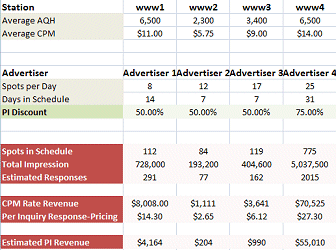| Monday, October 14, 2013 |  |
 |
 |
 |
 |
 |
 
 
 |
 |


 A New Breed of Indie Artists
A New Breed of Indie Artists Free Music and Programs for Radio and Podasters
Free Music and Programs for Radio and PodastersNothing Happens Until Radio Uses the Data
|
There's a boiling buzz that streaming is hot! Read any radio industry trade for reports about Pandora doing this, iHeartRadio that, or Cumulus deals with Rdio. Then we have the "others" which receive practically no trade press mentions. Tens-of-thousands of audio programs online from Live365, Shoutcast, MyRadio, Radionomy, Blog Talk Radio; we could go on, and on, and on... Oh, and there are podcasts, too. |
"Are you merely handing over a data set that says how many people were listening and how often the client's ad played? What is it that your radio station is doing for advertisers, post campaign?" |
Although doing streaming, few of the above mentioned groups are considered "digital" because they geo-target ads. (Album art, "Buy Buttons," Video pre-rolls, in-player banners and sharing are also the "new" offered consumers today by an increasing number in online radio.)
There's one piece of the past which doesn't go away, though. While digital offers a strict accounting of audience, with numbers racked up at lightning speed on dozens of data-points for each move made by the consumer, nearly all in the online audio industry still charge advertisers based on impressions served. The latest example is in CBS Radio's new online ad sales home for its radio streams.
"Audio Adcenter" is a concept representing everything that radio shouldn't be online. Advertisers are given a choice of commercials from a list - this is antithesis to how radio advertising works best (move emotion and you'll move product). 1,500; 3,000; 7,000 impressions a month are promised, which is no different than how most online audio advertising is bought.
When your online media is pitted against Google AdWords, MSN AdCenter, or dozens of other digital platforms, selling ads by impressions is futile.
The magic in online ad services which charge for response is that they increase the display of successful ads, generating higher return for the ad serving company. AdWords run ads with high CTR (click-through-rate) more frequently, increasing Google's revenue.
Digitally savvy companies are buying "response metrics." Advertising sellers have teams which analyze data and help the advertiser because, in this world, the better the advertisment does the more money is made by all.
Are you merely handing over a data set that says how many people were listening and how often the client's ad played? What is it that your radio station is doing for advertisers, post campaign?

 What happens when they changed a phrase in the banner?
What happens when they changed a phrase in the banner?
 Which landing page performs better - 1, 2, or 3?
Which landing page performs better - 1, 2, or 3?
 What does moving the buy button to the lower left do for conversions?
What does moving the buy button to the lower left do for conversions?We often hear how the online radio industry does not receive its fair share of ad revenue. That may be because online radio stations have yet to compile data in meaningful ways, or offer advertisers a different approach to how their commercials perform - by tracking response. Consider selling by response as today's PI (per inquiry) campaign refined.
I've created a spreadsheet that helps determine how to set Per Inquiry pricing for the radio industry. The beige-colored rows are where you plug numbers into the cells that fit your station, and where advertiser needs are set. The green row is where you set the discount (off your station's average CPM rate). The rose-colored areas do automatic calculations.
 (Click to Expand)
(Click to Expand)
Advertising has always evolved, but what we're seeing now is different in this respect: The speed of change has never been greater.
From reporting response to setting price, more companies are depending on numbers to make decisions - decisions on where to place ad dollars. That's why our radio industry must use its online data sets. When analyzed, these are far more than just a set of numbers.
Today's indie artist introduction is to...
| Spiritual music artist Skylar Kaylyn. |
 sample song |
Happy Ever After Download Song
|
Give Skylar Kaylyn's "Happy Ever After" a listen.
Add it to your playlist, free! Such is the new world of music distribution.
It's time internet radio programmers reach into a huge pile of untapped talent.
It is here where new hit songs will increasingly be found.
More Articles
 |
 |
 |
comments by Disqus |

